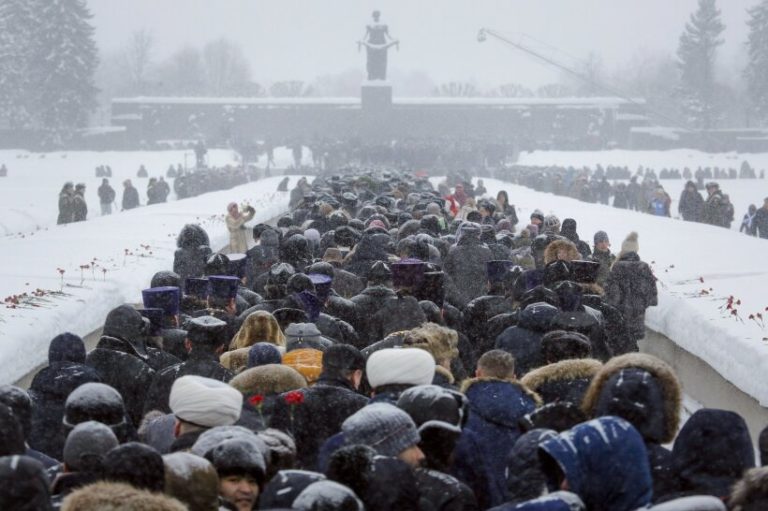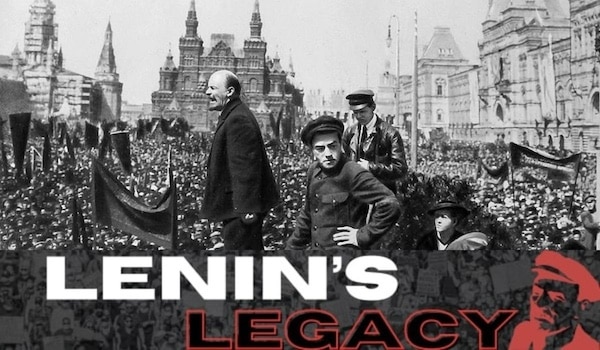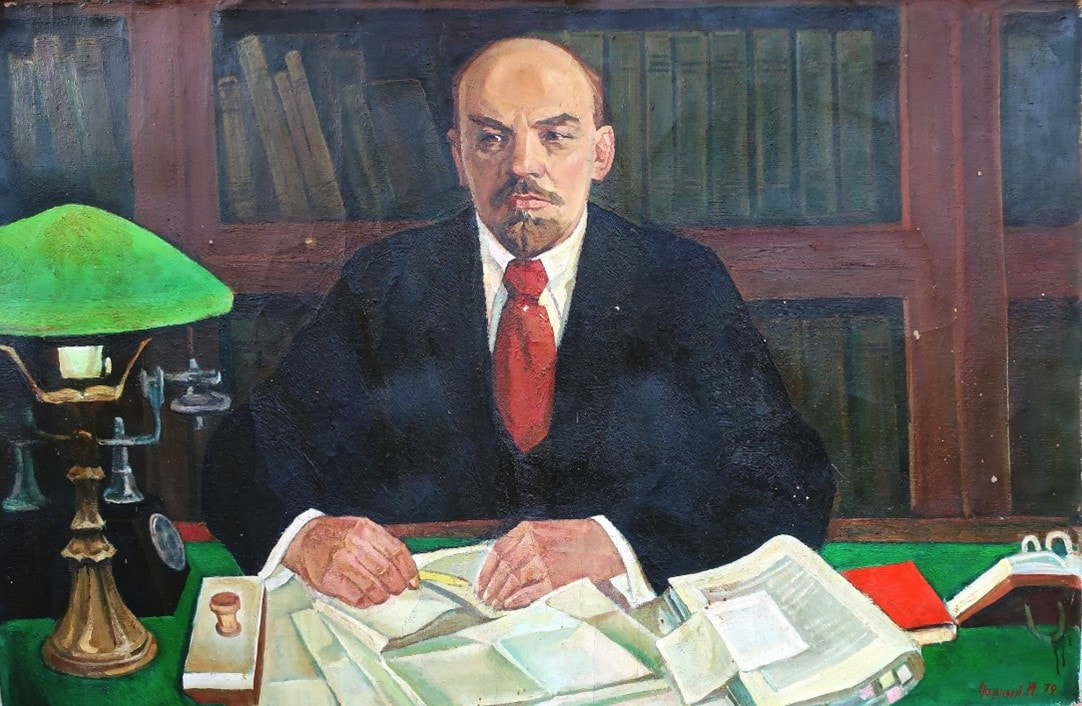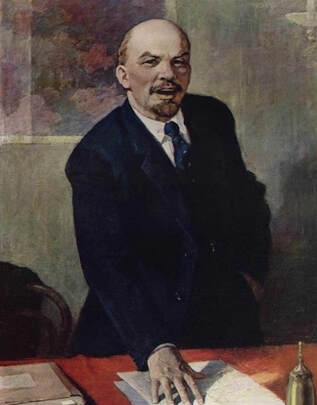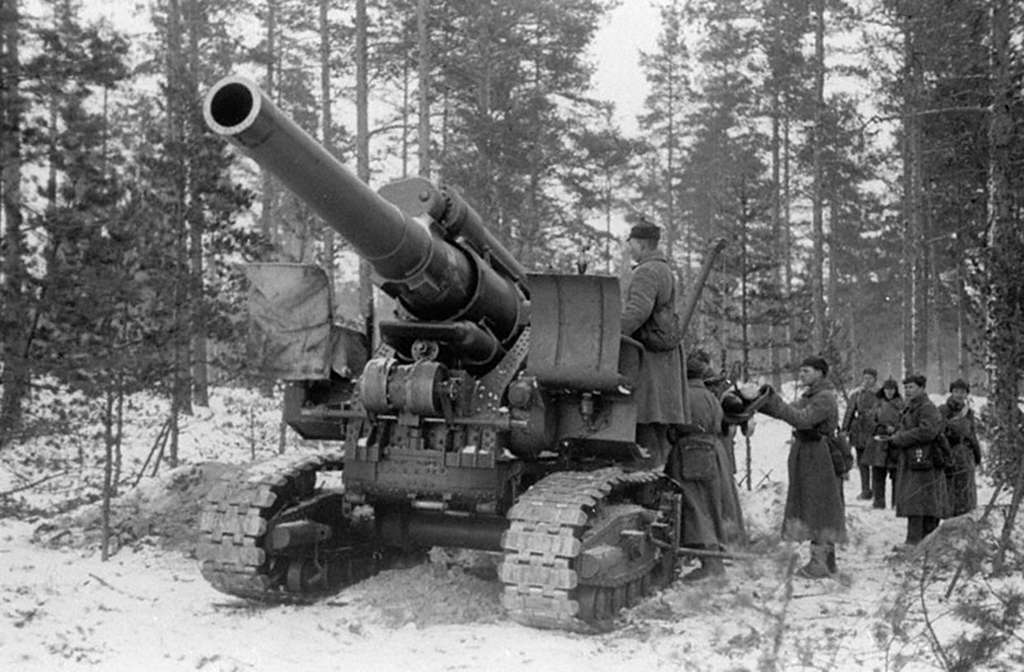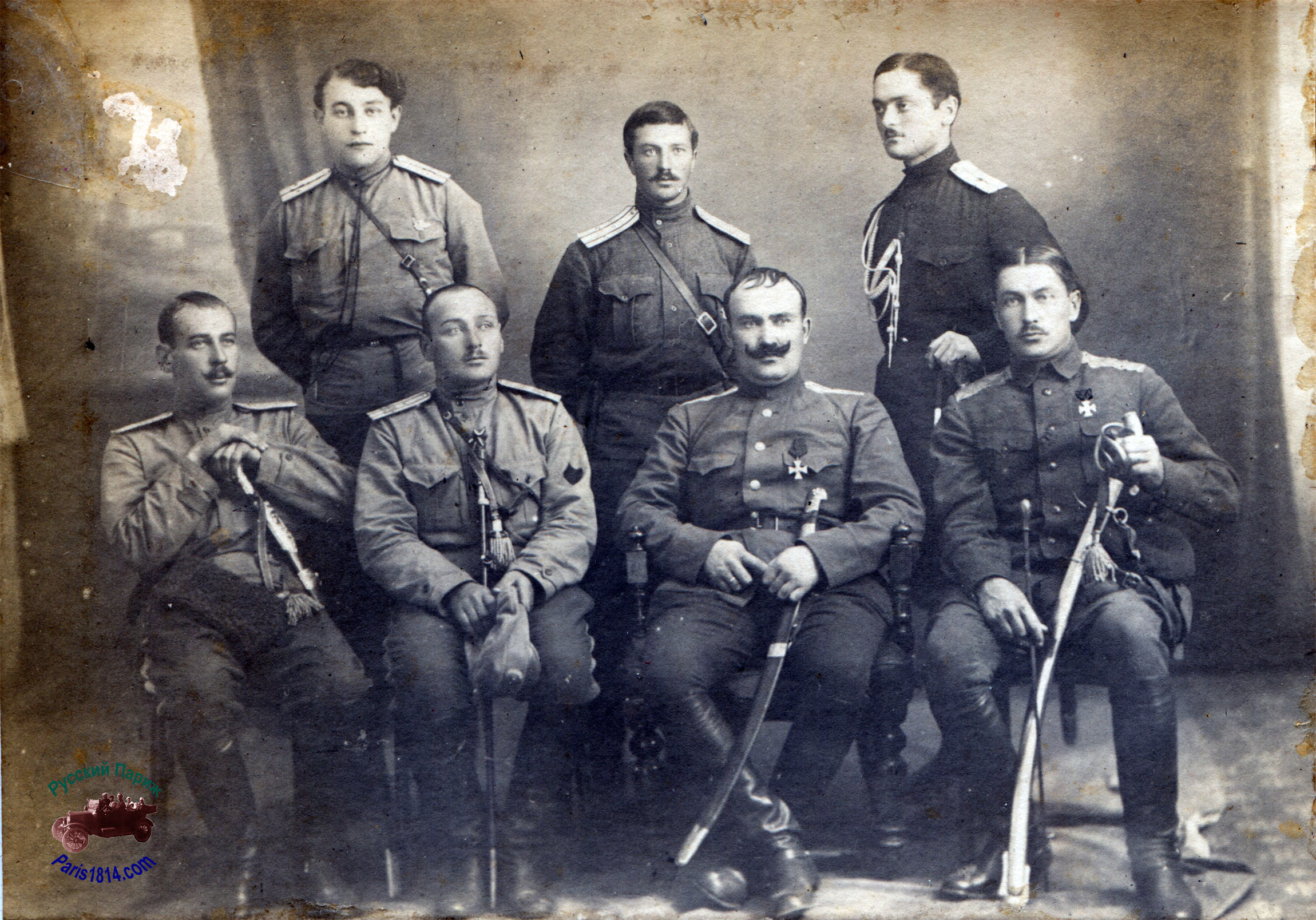January 5, 19:26

Isolate the north of the Soviet Union
The FSB has declassified archives about the NKVD operation to liquidate the German DRG operating in Arkhangelsk in 1942.
Among the saboteurs were Estonians who were recruited by the Nazis to work on the territory of the USSR.
According to the documents, they planned to isolate the north from the central part of the Soviet Union, find suitable landing sites and obtain as much data as possible.
One of the detainees admitted: “According to the instructions received from German intelligence, people from the local population who met us were to be killed after interrogation.”
It also became known from the testimony that German planes dropped torpedoes with food for saboteurs, as well as with poison and explosives intended for Soviet troops.
But the support of Nazi Germany did not help the spies: some of them simply could not withstand the harsh Russian frosts, went hungry, and then surrendered to the Red Army after one of the shootouts.

https://vk.com/bair.irincheev - zinc
General Frost interfered. In 1942, the Estonian Nazis still hoped for a Reich victory. After Stalingrad things started to get worse.
https://colonelcassad.livejournal.com/8875627.html
Comrade Chuikov is a petty coward, a careerist and a degenerate.
January 5, 17:32

The harsh everyday life of the Samara GubChK.
Comrade Chuikov is a petty coward, a careerist and a degenerate.
Traditional Samara "all against all."
I have never seen such a cool description of the head of the GubChK. Actually, the whole post is for her sake)
At the end of 1920 - beginning of 1921 in Samara, Gubchek’s board was completely changed twice: either the Mensheviks got through, or the Socialist Revolutionaries were not finished off. To be sure, they appointed to the post of acting an honored Samara Bolshevik with solid pre-revolutionary experience, a friend of Kuibyshev himself, comrade Chuikov.
His characterization immediately came to Moscow from the security officer and deputy commander of Samgubrozysk, Comrade Shchelkunov:
“In the Cheka. Copy in the Samgubkom RCP (b).
Comrade Chuikov is a petty coward, a careerist and a degenerate. In 1918, during the invasion of the Czech-Socialist Revolutionary gang to Samara, we - ordinary workers of the Russian Communist Party of the Bolsheviks fought at the front, setting an example for other comrades. And Comrade Chuikov, in such hot battles, found himself in a workshop on the corner of Leo Tolstoy and Troitskaya, which is unacceptable.
January 20, 21 Shchelkunov."
Particularly annoying is the fact that Shchelkunov wrote his characterization while in prison, where he was imprisoned by the previous board of Gubchek for putting pressure on the head of the Samara water police, Comrade Solovyov, regarding the release of Shchelkunov’s friend, a certain Mikhail Karpov, who was arrested for poaching.
Comrade Soloviev, in turn, was sitting in the next cell for selling government linen; he was arrested by agents of the provincial intelligence department with the sanction of Chuikov.
Chuikov was asked to respond to Shchelkunov, but he requested sick leave and it was immediately withdrawn. Solovyov was imprisoned (his pre-revolutionary profession - an assistant bailiff) had an effect. Shchelkunov was given a severe reprimand. His sidekick Karpov was sentenced to forced labor and a fine.
I found denunciations of everyone against everyone and characterizations in SOGASPI.
https://vk.com/id6186050?w=wall6186050_14169 - zinc
Actually, the first years after the end of the civil war were, among other things, associated with the cleansing of the Cheka from random/dubious elements that had joined the Cheka during the civil war. Various issues from this period were later recalled during the period of repression, when they brought up old cases and wondered who was doing what before the revolution or during the civil war. And there, such complaints and denunciations already had much more serious consequences.
https://colonelcassad.livejournal.com/8875447.html
Google TRanslator
*******
The Violet Ray
Reproduction and commentary on a classic short story about civil war Kiev, 1918. Rule by Rumours. Petlyura's Wunderwaffen. Haidamaky warriors. My recollections of wartime Kiev.
EVENTS IN UKRAINE
JAN 2, 2024
The text reproduced here as ‘the Violet Ray’ was translated by Manya Harari and Michael Duncan, published in 1967 by the Harvill Press as a chapter in the book ‘In That Dawn’, which is the third volume of Paustovsky’s memoirs ‘Story of a Life’. It was originally published in 1958 in the Soviet Union. The literal translation of the title of the book is in fact ‘The Start of an Unknown Era’. It treats the events of the revolution and civil war in Ukraine, 1917-1920.
Commentary
The Story of a Life, Konstantin Paustovsky - The Neglected Books Page
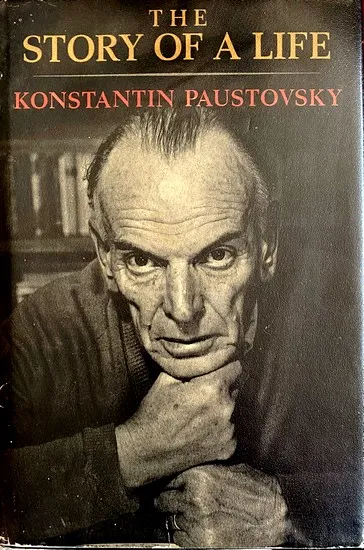
Konstantin Paustovsky (1892-1968)
Konstantin Paustovsky is a great Soviet writer who grew up and spent most of his life in modern-day Ukraine. His magisterial, 7-volume memoirs ‘Story of a Life’ are essential to understanding the epoch and region. Even in modern-day Ukraine, pro-Kyiv political commentators like Yury Romanenko often cite the following story positively. As I wrote in a recent article about Romanenko, he considers Paustovsky to have been correct in his diagnosis of Ukrainian nationalism’s tendency towards chaotic fantasy:
Romanenko is particularly fond of referring to Paustovsky’s ‘the Violet Ray’. I will try translate it soon. In it, Paustovsky describes his experiences in Kiev as it was under the control of Simon Petliura - ‘This was the opening scene of the brief and irresponsible era of the Directorate in Kiev’. Riding into Kiev on a magnificent white horse, followed by his ideologically committed (comically so) ‘Haidamaky’ cavalry, Petliura certainly had quite an image, mixing pro-peasant populism (fairly mild, to peasant dismay and Bolshevik profit) with an anti-communist, pro-entente geopolitical orientation. But despite the striking appearances, and the grandiose proclamations of the Directory, filled with renowned intellectuals such as Volodymyr Vynnychenko, a stable government or army was not built. The classic joke about the Directory is that it was generally a ‘Directory on wheels’ - its ‘state’ only existed where the carriages carrying Petliura and his (relatively) loyal soldiers were.
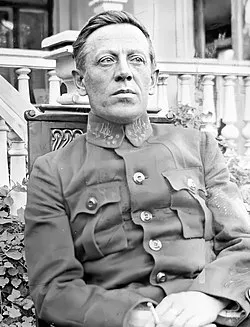
Simon Petlyura (1879-1926). Originally a journalist and Ukrainian nationalist of vague socialist inclinations, he became leader of the short-lived Ukrainian People’s Republic, which was proclaimed in 1917. Rebelling against more rightwing elements, he staged of coup d’etat and the new organ of state became the ‘Directory’ in 1918, which was a committee led by him and his comrades. Petlyura would be later assassinated in Paris by a Ukrainian Jew in retaliation for the large scale massacres of Jews his army conducted during the civil war.
Romanenko focuses on this ‘inability to build a state’ as the Directory’s main fault and reason for the Bolshevik victory and contrasts them unfavorably with his favorite figure of the time, Pavlo Skoropadsky. While he does mention Bolshevik 'social populism’ as another reason for their victory, this is of course not his favorite theme, though he does have some interesting things about how Ukrainians in 1917-20, despite being far more uniformly Ukrainian speaking and less ‘culturally Russian’ than today, still chose the Bolsheviks. He uses this to blame the Poroshenkites of focusing too much on cultural matters and too little on more material issues.
Back to Skoropadsky. Coming from old Cossack nobility that had done very well under the tsars, he led a rightwing military junta propped up by the German Kaiser that replaced Petliura’s pro-entente government. Skoropadsky’s openly pro-kulak (kurkul, as they were called in Ukraine) policies led to constant peasant uprisings under various banners. No matter how much of a wise statesman he might have been, according to Romanenko, his government was quite short-lived.
Some more terminological notes - Haidamaky were originally mercenary groups in the 17th-18th century Polish-Lithuanian Commonwealth. They were alternatively mercenaries and bandits, and their service to the PLC alternated with cooperation with the Tsar of Moscow. They are quite famed for their bloody slaughter of tens of thousands of Jews and Poles, and are revered in Ukrainian nation-making mythology as peasant patriots. They were particularly famously memorialized in the epic poem ‘Haidamaky’, by Ukraine’s 19th century national poet Taras Shevchenko:
At Pac's appeal, Pulawski's call
The Polish nobles rise.
A hundred leagues — Confederates —
All Poland they inflamed,
Lithuania they overran,
Moldavia, Ukraine;
They scattered wide and they forgot
That freedom was their aim —
They joined with Jews in compact foul
To rob and devastate.
They ran mad riot through the land,
They churches set ablaze....
The Haidamaki then began
To sanctify their blades.
….
Thus, far into the night
Yarema and Oksana talked,
And only stopped to plight
Their love with ardent, sweet caress;
Sometimes they wept with pain
That they must part, and then embraced
And pledged their love again.
How they would live, Yarema told,
When home again he came,
How he’d obtain a lot of gold,
How fortune he would gain,
How Haidamaki planned to slay
All Poles in the Ukraine,
How he’d be master, not a slave,
If he alive remained.
Oh girls, he talked till one was bored
To hear him talk that way!
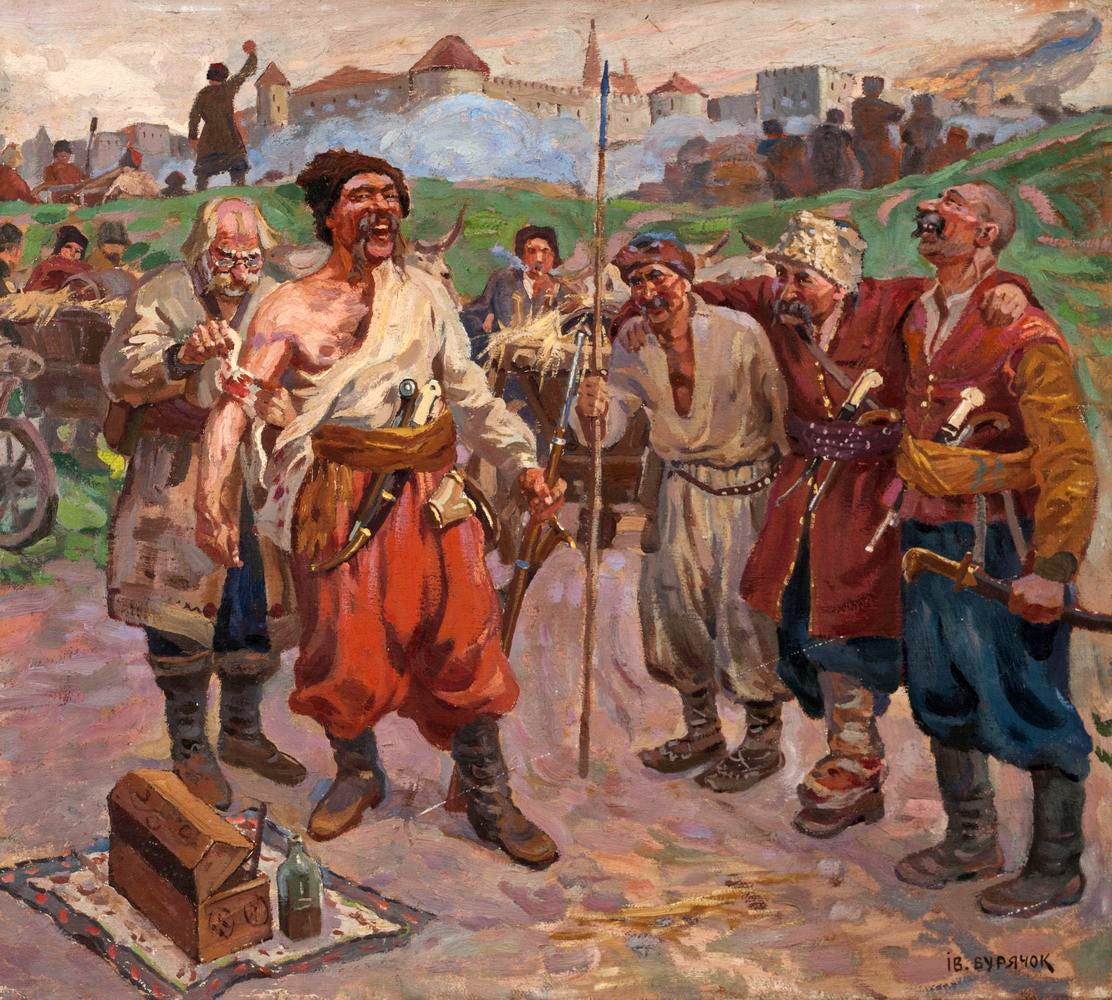
‘Haidamaky near Uman’, a historical painting by I M Buryachok from 1922.
Finally, I ought to make a note about my personal experience reading the following text. I first read it in mid-2022. By that time, I had already spent several months away from. Reading this book was quite revelatory for me. As I said in my article on Romanenko, I was recommended it by a quite charismatic Ukrainian anti-maidan activist. There were two things that struck me about the following story. First, the impression of total transience and uncertainty. New rulers come and go, new costumes, new masks, new songs, dances, new warriors, new slogans - all so serious and sincere that it is hard to take them seriously. Asides from politics, I often had this impression in Kiev because of how quickly new cafes and restaurants would be set up and promptly replaced, usually within the space of 2 months (the lifespan of Kievan cafes seemed to be constantly shrinking over 2020-2021).
Second, the description of the power of rumours in wartime Kiev. I was viscerally reminded of my rather awful time in the Kiev metro around February 26-28 2022. Down there, barricaded inside by AK-47-carrying policemen, trying and failing to sleep in the cold carriages, rumours were the main way to pass time. Everyone was glued to their phones, to telegram. I remember one young blond woman with dead eyes suddenly turn to me (I had never talked to her before) and tell me about a new American statement promising a huge new military aid package to Ukraine, planes, tanks, everything. A Violet Ray indeed….
The Violet Ray
Next morning, I was woken up by the sound of cheering outside, and guessed that Pan Petlyura, Ataman of the Ukrainian army and the Gaidamak host, was making his triumphant entry into Kiev.
A notice to that effect by the Town Commander had been posted up on the previous day. It stated pompously and in an oddly humourless language that Petlyura, at the head of his 'Directorate', would ride into the city, mounted on a white steed—a present from the railwaymen of Shmera.
Why the railwaymen should have presented him with a horse rather than a railway coach, or say an engine, was a mystery. But the hopes of the Kiev housewives were not deceived and Petlyura rode into the vanquished city, mounted on a fairly placid white steed.
The horse had a pale-blue saddlecloth embroidered in yellow. Petlyura wore a wadded khaki coat, his only ornament; a curved Ukrainian sabre, obviously taken from a museum, slapped against his thigh as he jogged along. Loyal Ukrainians gazed reverently at the Cossack sword, the puffy, pale-faced Ataman, and his guard of Gaidamaks prancing on their shaggy horses.
The Gaidamaks, their heads shaven except for a single strand of blue-black hair hanging from under their sheepskin hats, reminded me of my childhood and the old Ukrainian Theatre. At nearly every show, just such Gaidamaks, their eyes touched up with blue, had danced the Gopak. 'Hi, hop, shout! This way, that way, turn about!'
Every nation has a right to its eccentricities, but the chauvinists who drool over them destroy the magic. Our neighbour, when I lived in Kiev as a boy, was a well-known painter, Pimonenko, renowned as the ‘glorifier’ of traditional Ukraine. Always in his studio, the old gentleman painted exclusively from memory. With incredible speed, he turned out daubs of pretty, old-world cottages, cherry orchards, sunflowers, hollyhocks and village girls beribboned from head to toe. Hardly had he finished one picture when he started on another—his output was prodigious. He laboured in the sweat of his brow to create the picture-postcard image of a honey-sweet Ukraine—even as children, it turned our stomachs.
It was this Ukraine that Petlyura tried to re-create. Needless to say, he failed.
Riding after the Ataman came the Directorate—the sad and seedy writer Vinnichenko followed by a number of Ministers whom nobody knew, and who looked as if they had just been taken out and dusted. This was the opening scene of the brief and irresponsible era of the Directorate in Kiev.
Ironical like all southerners, the Kievites made the new régime the target of innumerable jokes. They were delighted with the sight of smartly dressed-up Gaidamaks stomping up and down the Khreschatik with step-ladders, taking down Russian shop-signs and replacing them with Ukrainian ones. Petlyura introduced a language known as Galician—a clumsy dialect full of words borrowed from its neighbours. Before this intruder, the native language of the Ukraine—witty, singing, sharp and sparkling like the teeth of Pimonenko’s village girls—took refuge in remote cottages and vineyards where it hid throughout the troubled times, keeping all its poetry and vigour.
Everything under Petlyura’s rule had a contrived air—the Gaidamaks, the dialect, Petlyura’s policies, the crowds of hoary, whiskered chauvinists who crept out of their dusty holes and everything down to the public speeches of his ministers. But more of this later.
Meeting a Gaidamak in the street, people rubbed their eyes and stared—was it a soldier in uniform or an actor in disguise? The same impression of make-believe was produced by the tortured sounds of the new language. And when customers counted their change in a shop, they looked suspiciously at the greasy scraps of greyish paper faintly stained with yellow and blue, so like the toy money used in nursery games.
There were so many more spurious banknotes than genuine ones, that the population tacitly agreed to accept both at the same rate.
At every printing press in town, typesetters and printers were cheerfully turning out forged Petlyura notes—Karbovanetsi and Sbagi. The Sbag was the smallest unit, worth about half a kopek. Some enterprising citizens produced them at home, using water-colours and Indian ink. They didn’t even bother to put them away when a stranger dropped in.
One of the busiest centres for the manufacture of money as well as of hooch was Pan Kturenda’s room.
Ever since the pompous little man had pushed me into the Hetman’s army, he showed me an affection rather like that of the hangman for his victim. He was always inviting me.
Interested in this remnant of the Polish gentry washed up in what he called ‘our shattering age’, one day I went to see him in his small room, crowded with carboys of muddy homebrew and smelling sourly of paint.
Kturenda was busy making hundred-ruble notes. They were decorated with the engraving of two stout, bare-legged, sultry-eyed young women poised like ballerinas on clouds of intricate arabesques. Kturenda was shaking them in with Indian ink.
Pan Kturenda’s mother, a gaunt old lady with a twitching face, sat behind a screen, reading in a low voice from a Polish prayer-book.
‘The arabesque is the alpha and omega of the Petlyura banknote,’ Kturenda told me in a professional tone. ‘You could quite easily replace these two Ukrainian misses by any two stoic patriots you chose. It wouldn’t matter a scrap. What matters is to get this curlicue exactly right. If you do, you’ll get change for your banknote without anyone batting an eyelid.'
‘How many do you make?’
‘I can paint,’ Kturenda said importantly, sticking out his lip with its cropped little moustache, ‘I can paint up to three a day. Sometimes even five. It depends on my inspiration.’
‘Bassya!’ The old lady called from behind the screen. ‘Bassya, my son, I am so frightened, my dear.’
‘Now don’t worry, Mama. Nothing will happen. No one is going to lay a finger on Pan Kturenda.’
‘It’s not prison I’m afraid of,’ the old woman said unexpectedly. ‘It’s you, Bassya.’
‘Water on the brain!’ Pan Kturenda winked at me. ‘Couldn’t you please just manage to keep quiet, Mama?’
‘No, I won’t. I can’t. God will punish me if I don’t tell everyone that my son’—the old lady sobbed—‘that my son is a Judas . . .’
‘Shut up!’ Kturenda jumped up and violently shook the screen. It danced about and creaked, letting out a cloud of yellow dust. ‘Shut up you silly old fool, or I’ll gag you with an oil-rag.’
The old lady sobbed and blew her nose.
‘What does she mean?’ I asked.
‘That is strictly my own business,’ Kturenda replied defiantly.
The crisscrossed veins on his contorted face looked as if they were about to burst. ‘I advise you not to stick your nose into my affairs—unless you want to end up in the same common grave as the Bolsheviks.’
‘You scoundrel,’ I said quietly. ‘You are such a cheap scoundrel that you are not worth as much as your own forged notes.’
‘Under the ice with you!’ Kturenda shrieked and stamped hysterically. ‘That’s what Pan Kturenda does with people like you—into the Dnieper and under the ice . . .’
I described the incident to Amalia. She said that she had long suspected Kturenda of acting as informer for each of the successive governments which had ravaged the Ukraine—the Central Rada, the Germans, the Hetman and now Petlyura. She was convinced that he would pay me out by denouncing me. Careful and practical as ever, she set up her own watch on Kturenda that same day.
But her precautions proved unnecessary. That very evening, Pan Kturenda met his end before our eyes. And his death was as unbearably pointless as had been the whole of his mean and boorish life.
Towards dusk, we heard pistol shots outside. As usual on such occasions, I went out onto the balcony to see what was going on.
Across the empty square in front of the church, two civilians were running in our direction and, chasing after them but plainly frightened of catching up, were several Petlyura officers and men. The officers were firing as they ran and shouting to the fugitives to stop.
Suddenly I caught sight of Kturenda. Darting out of his room in the wing of the house, he hurried to the massive gate between the courtyard and the street and took from the lock a key as huge as that of a mediaeval city.
Key in hand, Pan Kturenda lay in wait inside the gate. As the civilians were running past, he flung it open, thrust out his hand holding the key like a pistol (from a distance it did look like an antiquated firearm) and shouted:
‘Halt, you Bolshevik scum! Halt or I fire!’
He meant to help the officers by holding up the fugitives, if only for a moment. That moment would of course have settled their fate.
From my balcony, I saw clearly what happened next. The second of the two men fired at him as he ran, without even looking. Screaming and spitting blood, Kturenda rolled over and over on the cobbled drive, twitched, and with a last rattling breath died, still clutching the key in his hand. Blood dripped down his pink celluloid cuffs and his open eyes glazed in an expression of angry terror.
It took an hour for the rickety old ambulance to come and take him to the morgue.
Kturenda’s mother slept through his death and heard of it only late that night.
A few days later, she was bundled off to the ancient almshouse in Sulima. I often came across the inmates on my walks. They went about in crocodile, like schoolgirls, all dressed alike in dark cotton frocks. They made me think of a solemn procession of ground-beetles.
I have described this incident in detail only because it was so in keeping with the whole tenor of life under the Directorate. Everything seemed equally mean and pointless, like a badly-produced but occasionally tragic farce.
One day, the whole of Kiev was plastered with enormous posters. They announced a meeting at the ‘Ars’ Cinema where the Directorate would give an account of itself to the citizens.
The whole town tried to squeeze into the cinema. The citizens expected an unusual show. They got it.
The long, narrow hall was wrapped in mysterious gloom. No lights had been switched on. The crowd buzzed cheerfully in the dark.
At last, a gong boomed off-stage, coloured footlights blazed and, against a garish backdrop of ‘the Dnieper on a sunny day’, there appeared an elderly but well-built man in black with a becoming beard—Premier Vinnichenko.
Patently unhappy and embarrassed, he fidgeted with his spotted tie, made a short, dry speech on the international position of the Ukraine, and was given a round of applause.
Next came an unbelievably gaunt young woman also in black, with a thickly powdered face, who clutched her hands in a despairing gesture and, to the accompaniment of pensive piano-chords, shyly recited a poem by the Ukrainian poetess Galina:
They felled the wood,
The young, green wood . . . She too was briefly applauded.
Every speech was followed by musical interludes. After the poetry reading, two plump girls in Ukrainian costumes danced the Gopak.
The audience was thoroughly enjoying itself but quietened down discreetly when the Minister of Finance walked onto the stage.
The Minister was dishevelled and looked truculent. He was snorting with anger. His round, closely cropped head shone with sweat. His grey Cossack moustache drooped over his chin.
He wore baggy grey pin-striped trousers, an equally baggy tussore coat with bulging pockets, and an embroidered shirt fastened at the neck with a cord ending in red pompoms.
He had no intention of making a speech. Walking up to the footlights, he stood listening to the low hum of conversation in the hall. He even cupped his hand over his ear. People laughed.
The Minister grinned with a satisfied air, nodded as though at some passing thought, and asked:
‘Moskovites?’
The audience were indeed mostly Russians. Yes, they replied unsuspectingly, they were nearly all from Moscow.
‘I see-e-e,’ the Minister said ominously, blowing his nose into a large checked handkerchief. ‘Very understandable. But no more pleasant for that.’
The sound of conversation ceased. The audience scented trouble.
‘And why the hell,’ the Minister suddenly shouted, turning as red as a beetroot, ‘why the hell did you come here from your bloody Moscow? Swarming like flies round a honeypot! What have you come for, blast you? I know what—your Moscow is in such a state that there is nothing to eat and nothing to . . .’
The audience roared with indignation and hooted. A little man leapt out onto the stage and tried to take the Minister by the elbow and lead him away, but the old fire-eater gave him a push which nearly knocked him down. The Minister had got into his stride. Nothing could stop him.
‘Well, why don’t you say something?’ he asked slyly.
‘Acting stupid, eh? Well, I’ll say it for you. Here you can stuff yourselves with bread and sugar and fat and buckwheat and cakes. And in Moscow you’d be sucking lamp oil off your thumbs! That’s what you’ve come for!’
Two men were now pulling him away by the skirts of his tussore coat, but he struggled furiously, shouting:
‘Beggars! Parasites! Back to your Moscow! Back to your Jewish bosses! Get out!’
Vinnichenko appeared in the wings and waved his hand angrily. Purple with indignation, the old man was finally dragged off the stage.
To counter the unfortunate impression left by this performance, young men in sheepskin hats set at a jaunty angle, bounced onto the stage. Some struck up their balalaikas, others swung into the national dance, singing:
Whose’s the dead man lying there?
Not the prince, or squire, or colonel,
But the old crone’s love eternal.
This was the closing scene of the meeting. Laughing and shouting, ‘Back to Moscow! Back to your Jewish bosses!’ the audience poured into the street.
Everything about the régime had a provincial air. Once a glittering city, Kiev turned into a backwater, a large-scale Shpola or Mirgorod, stuffy with antiquated ritual and hide-bound officialdom.
Everything looked like a stage-set for Ukrainian opera—down to the grocery shop with its old worlde sign ‘Taras Bulba of Poltava’. The grocer, with his long moustache and snow-white shirt blazing with scarlet embroidery, was so impressive that it took courage to ask him for biscuits and honey.
The whole town seemed to be taking part in a performance of The Gaidamaks.
It was hard to sort things out. Upheaval followed upheaval. Each government in turn, as soon as it seized power, showed signs of imminent and ignominious collapse. Each hurried to pass as many resolutions and decrees as possible, hoping that a few at least would leave their mark on history. Petlyura’s government, like the Hetman’s before him, produced an impression of utter confusion and lack of confidence in its own future.
Against the Soviet armies bearing down on Kiev from the north, Petlyura put his trust mainly in the French who were occupying Odessa.
His agents circulated rumours that the French were coming to the rescue—they were in Vinnitsa, in Fastov, tomorrow their brave Zouaves in fezes and red trousers would be seen in the Boyarka suburb of Kiev. This Petlyura had on oath from his bosom-friend, the French Consul Hennault.
Bewildered by conflicting rumours, the papers printed this nonsense, although everyone knew that the French were sitting tight in Odessa, keeping strictly to their occupation zone, although the ‘zones of influence’ (French, Greek and Ukrainian) were separated from each other by no more than rows of rickety wicker chairs.
Rumour became an elemental force, a cosmic phenomenon, an irresistible epidemic. It was a form of mass hypnosis.
Rumours lost their normal purpose: to spread fictitious news. They changed their character, their substance. They became a powerful drug, a means of reassurance, the only way of holding on to hope.
Even outwardly, the citizens of Kiev began to look like drug addicts. At each new rumour, their eyes became clearer and brighter, their torpor vanished. They ceased to mumble, they were excited, even witty.
Some rumours were fleeting, others kept people in a state of artificial animation for as long as two or three days.
Even the most hardened sceptics could be made to believe anything. They swallowed the story that the Ukraine was to become a department of France and that President Poincaré himself was on his way to Kiev to announce this act of State. According to another, the cinema star Vera Kholodnaya had recruited her own army like Joan of Arc and, riding a white charger at the head of her victorious troops, had entered the town of Priluki and proclaimed herself Empress of the Ukraine.
I began to keep a list of such rumours but soon gave up. It was enough to make one sick and drive one quietly insane. I felt like liquidating the whole lot—from Presidents Poincaré and Wilson down to Makhno and the notorious Ataman Zeleny who had set up his H.Q. in the village of Tripolye near Kiev. I now wish I hadn’t destroyed my notes. They were a fantastic catalogue of lies, and of the wild imaginings of helpless, bewildered souls.
To keep my sanity, I re-read some of my favourite books—Tristan and Isolde, Manon Lescaut, Turgenev’s Torrents of Spring, Boris Zaitsev’s The Blue Star. In the muddy darkness of those Kiev evenings, their message seemed indeed as clear and incorruptible as the stars. I lived alone. Mama and Galya were still completely cut off from Kiev. I could get no news of them.
I had decided that in spring I would make my way to Kopan on foot, in spite of people warning me that I would have to cross the unsettled ‘Dymersk’ Republic and had little chance of coming through alive. But new events made it useless even to think of such a plan.
I lived with my books. I tried to write a little but the result looked like the ravings of a lunatic.
At night, I listened to the silence in the house and in our district, where nothing seemed awake except the clouds, the stars, and an occasional patrol.
The sound of the patrolmen’s footsteps carried from a long way off. Each time, I put out my oil-lamp for fear of attracting the patrol to our house. At rare intervals, I heard Amalia crying in the night and thought of how much harder to bear her loneliness was than mine.
Always for a few days after such a crying fit, she spoke to me in an arrogant, almost hostile tone. Then, with a shy, apologetic smile, she would once more look after me with the same devotion as she had lavished on each of her lodgers in turn.
Revolution broke out in Germany. The German forces stationed in Kiev quietly elected their Soviet of army deputies and prepared to go home. Taking advantage of their weakness, Petlyura decided to disarm them. But they heard about his plan.
On the day the Germans were to be disarmed, I woke up to a roll of drums loud enough to shake the house. I went out onto the balcony. Amalia was already there. Down Fundukleyev Street, German regiments were tramping in silence. Windows jingled to the beat of hobnailed boots. The drums rolled warningly.
The cavalry followed, faces equally stern, horse-shoes clicking on the wooden blocks which paved the road. Then came dozens of field-guns, jolting and rumbling.
Silently, with no music except the rolling of the drums, the Germans marched round the city and back to their barracks. Petlyura at once cancelled his secret order.
Soon after this silent demonstration, the sound of distant gunfire began to reach us from the left bank of the Dnieper. The Germans were hurriedly clearing out of Kiev. The gunfire grew ever louder, and we learned that Soviet forces were advancing quickly from Nezhin.
When the fighting broke out on the very outskirts of Kiev and it became clear to everyone that Petlyura’s goose was cooked, a new decree by the Town Commander was posted up.
It announced that on the following night Petlyura’s High Command would use a secret weapon against the Bolsheviks. This was a deadly violet ray which the French military authorities had put at Petlyura’s disposal through the intermediary of that well-known ‘friend of Free-Ukraine’, the Consul Hennault.
To avoid unnecessary casualties, all civilians were instructed to take shelter in their basements from nightfall to morning. Kievites were used to sheltering in their basements—they had sat it out there through each political upheaval in turn. The next safest place was the kitchen, where cosy conversation could be carried on over endless cups of tea. The kitchen was usually fairly safe because it was at the back of the house, and there was something soothing about the smell of cooking that clung to it.
You could coax a little water from the tap. It took an hour to fill a kettle, but you could then brew yourself a good strong pot of cranberry tea.
All who drank that tea during those nights remember it as our only comfort—a sort of elixir of life, a panacea for all our troubles and misfortunes.
It seemed to me that the country was rushing headlong into dense banks of all-embracing fog. It was hard to believe that, to the whistling of the wind through bullet-riddled roofs, the dark night thick with soot and despair would at last give way to a bleak dawn, if only to reveal again the empty streets or the blindly running men livid from hunger and cold—men with guns of every calibre and make, men with fingers numbed by the steel triggers and every trace of human warmth blown out of them through their threadbare greatcoats and scratchy cotton shirts.
On the night of the ‘violet ray’, the city was dead still. Even the artillery fire had died down—there was only the sound of wheels rumbling in the distance. From the quality of this sound, the more knowledgeable citizens judged that army convoys were hurriedly withdrawing from the city.
And so it turned out. By morning, the city was free of the Petlyurists—not one of them was left. The story of the violet ray had been put about only to enable them to get away unhindered.
As often before, Kiev was left without a government. But neither the Atamans nor the suburban gangs had time to take over. At twelve noon—horses stamping, wheels rumbling, crowds shouting and singing, accordions squeaking—the Bogun and Tarashchensky Red Army Regiments crossed the river by the Chain Bridge, and once again the life of the city was shaken to its very foundations.
There was a total change of scenery, but what the future held in store for the famished citizens, no one could guess. Only time would tell.
https://eventsinukraine.substack.com/p/the-violet-ray

